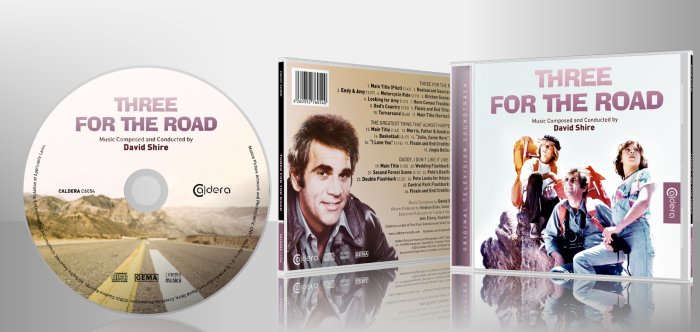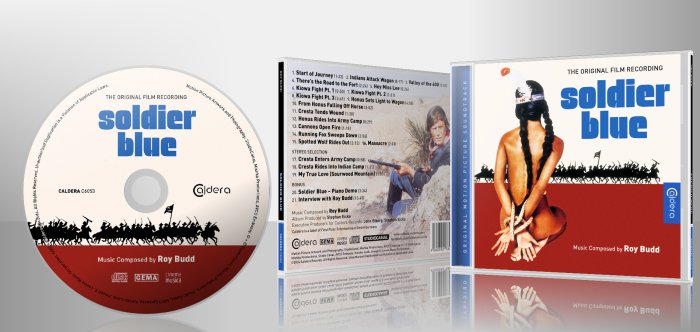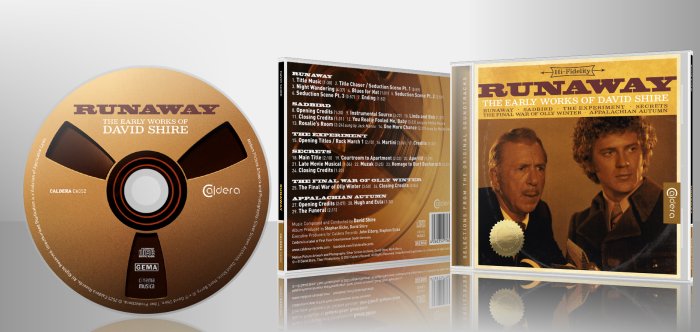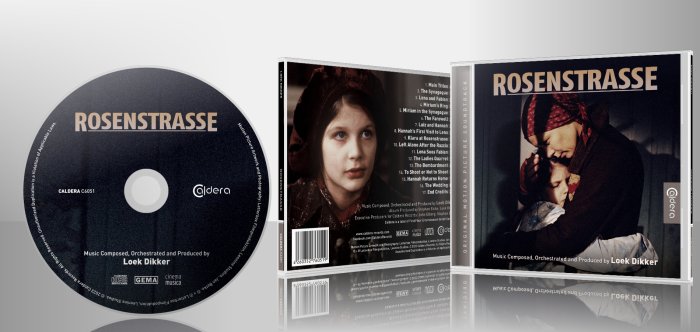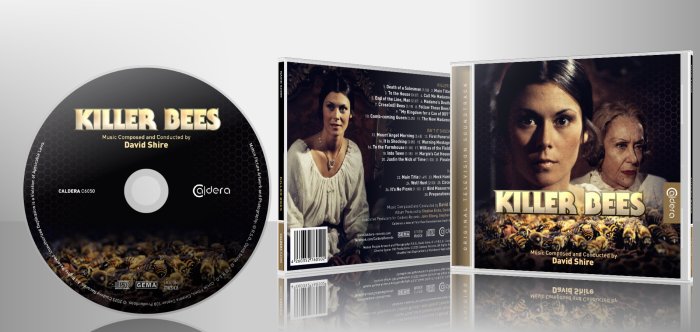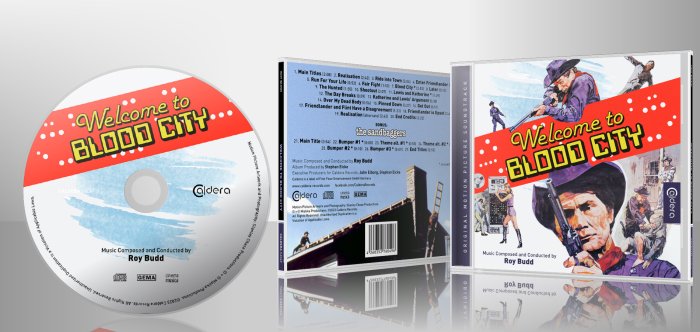-
Gesamte Inhalte
10 -
Benutzer seit
-
Letzter Besuch
Letzte Besucher des Profils
Der "Letzte Profil-Besucher"-Block ist deaktiviert und wird anderen Benutzern nicht angezeit.
Leistungen von Caldera Records

Member (2/4)
9
Reputation in der Community
-
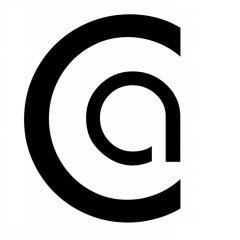
Caldera: THREE FOR THE ROAD (David Shire)
Caldera Records erstellte ein Thema in Scores & Veröffentlichungen
Caldera Records is proud to present David Shire’s score for the TV pilot “Three for the Road.” “Three for the Road” (1975) was an ambitious idea, a road trip as a family show, mostly shot on location throughout the US. While the show allowed for levity throughout, at its heart it dealt with loss and the desire to (re-)connect. Pete (Alex Rocco) is the kind of father every kid wants to have. He is kind and cool. He lets his two boys ride a motorcycle, while always providing emotional support when needed. And needed it often is, as his two kids, John (Vincent Van Paten) and Endy (Leif Garrett), have recently lost their mother. Now the three live in a recreational vehicle in which they drive through the United States while Pete takes on commissions as a photographer. While Bruce Broughton provided the music for the individual episodes, David Shire was contracted to score the pilot. His score is built around his main theme, a memorable, uplifting piece that makes its appearance throughout the pilot, and with its use of guitar featuring subtle folk elements. It’s a varied score also incorporating lounge jazz pieces, and for the more intimate moments, elaborate string writing. In addition, we also include music from “The Greatest Thing That Almost Happened” and “Daddy, I Don’t Like It Like This,” two TV movies that also deal with trauma. For the former, Shire provided a rousing, energetic sports score with gentler, tender moments to illustrate the illness of the main character. Shire’s score for the latter film is built around a lullaby-like main theme, often performed on a solo instrument such as a clarinet or piano. This music perfectly captures both the main protagonist Peter’s child-like wonder and also the longing of his parents. The theme is used, for example, both as Peter escapes into the woods and as his father lays on his bed, indulging in his memories of happier times when everything seemed possible. The boy’s escapes enable Shire to infuse his compositions with drive and verve that make “Daddy, I Don’t Like It Like This” an eclectic listening experience. The 54th CD-release of Caldera Records features a detailed booklet text by Stephan Eicke and elegant artwork by Luis Miguel Rojas. The CD was mastered by Richard Moore and produced by Stephan Eicke and John Elborg. C6054 Music Composed and Conducted by David Shire Album Produced by Stephan Eicke, David Shire Executive Producers for Caldera Records: John Elborg, Stephan Eicke Album Art Direction and Design by Luis Miguel Rojas For more information and sound clips, please visit our homepage: https://www.caldera-records.com/three-for-the-road Three for the Road 1. Main Title (Pilot) (1:41) 2. Restaurant Source (2:14) 3. Endy & Amy (1:27) 4. Motorcycle Ride (2:19) 5. Kitchen Scene (2:14) 6. Looking for Amy (1:31) 7. Here Comes Trouble (0:56) 8. God’s Country (3:33) 9. Finale and End Title (1:43) 10. Turnaround (0:48) 11. Main Title (Series) (1:08) The Greatest Thing That Almost Happened 12. Main Title (1:42) 13. Morris, Father & Sandra (1:14) 14. Basketball (3:17) 15. “Julie, Come Here” (2:46) 16. “I Love You” (1:16) 17. Finale and End Credits (1:58) 18. Jingle Bells (2:29) Daddy, I Don’t Like It Like This 19. Main Title (1:53) 20. Wedding Flashback (2:51) 21. Second Forest Scene (2:12) 22. Pete’s Death (2:53) 23. Double Flashback (2:22) 24. Pete Looks for Helen (0:57) 25. Central Park Flashback (3:31) 26. Finale and End Credits (2:44)- 3 Antworten
-
- veröffentlichung
- score
-
(und 2 weitere)
Markiert mit:
-

Caldera: SOLDIER BLUE - Film Recording (Roy Budd)
Caldera Records antwortete auf Caldera Recordss Thema in Scores & Veröffentlichungen
Jein: Wenn sie sich schlecht verkauft, werden wir nicht nachpressen- 7 Antworten
-
- roy budd
- soldier blue
-
(und 3 weitere)
Markiert mit:
-

Caldera: SOLDIER BLUE - Film Recording (Roy Budd)
Caldera Records erstellte ein Thema in Scores & Veröffentlichungen
Caldera Records is proud to present the original film recording of Roy Budd’s score for the film “Soldier Blue.” Ralph Nelson’s violent western starring Peter Strauss, Candice Bergen and Donald Pleasance, is both an indictment against the US army that was responsible for the Sand Creek Massacre as well as an allegory to the My Lai Massacre. How the former child-prodigy Roy Budd, the then 22-year old from Croydon, secured the gig for “Soldier Blue” is by now widely known, not least because the composer himself would share the anecdote with great wit in interviews: Upon hearing that the director was looking for a composer to score his upcoming western, Budd supplied him with a tape of his work as a showreel. Unbeknownst to director Ralph Nelson and others involved in hiring the composer, none of the music featured on said showreel was actually composed by Budd. Instead, he had taped compositions by Jerry Goldsmith, Elmer Bernstein, Lalo Schifrin and Henry Mancini. Unsurprisingly considering the selection, Nelson was convinced Budd was the right choice to score “Soldier Blue.” Budd delivered a memorable, energetic and varied score that can bear comparison with Goldsmith’s, Bernstein’s, Schifrin’s and Mancini’s efforts from the time. It is an astonishing work, especially considering it was composed by a 22-year-old. Its mix of differing musical elements and styles is particularly noteworthy, in that Budd pays homage to the classic Americana of Jerry Goldsmith and Elmer Bernstein while employing jazz and pop music sensibilities with a strong sense of rhythm. In that sense, “Soldier Blue” is not dissimilar to Quincy Jones’ groundbreaking “MacKenna’s Gold” and Piero Piccioni’s “Minnesota Clay,” which fused symphonic music with jazz as well as pop elements, and thus introduced a new approach to the western genre. It is not surprising that several compositions for “Soldier Blue” were re-recorded in pop arrangements and released on PYE Records, with which label Roy Budd was under contract at the time. We are delighted to finally make Roy Budd’s original film recording for “Soldier Blue” available. The recording was long considered lost before we unearthed the mono copies from Budd’s estate, in a storage container in North Yorkshire. Unfortunately, a few pieces were missing (such as ‘Fields of Green and Skies of Blue’), while only a short selection was available on a separate stereo tape. We have included those pieces as a bonus. The 53rd CD-release of Caldera Records features a detailed booklet text by Stephan Eicke and elegant artwork by Luis Miguel Rojas. The CD was mastered by Richard Moore and produced by Stephan Eicke and John Elborg. For more information and sound clips, please visit our homepage: https://www.caldera-records.com/soldier-blue Soldier Blue 1. Start of Journey (1:32) 2. Indians Attack Wagon (8:17) 3. Valley of the 600 (1:01) 4. There’s the Road to the Fort (2:24) 5. Hey Miss Lee (0:26) 6. Kiowa Fight Pt. 1 (0:50) 7. Kiowa Fight Pt. 2 (1:31) 8. Kiowa Fight Pt. 3 (3:41) 9. Honus Sets Light to Wagon (4:58) 10. From Honus Falling Off Horse (3:02) 11. Cresta Tends Wound (1:30) 12. Honus Rides Into Army Camp (0:29) 13. Cannons Open Fire (1:18) 14. Running Fox Sweeps Down (2:56) 15. Spotted Wolf Rides Out (2:12) 16. Massacre (2:03) Stereo Selection 17. Cresta Enters Army Camp (0:58) 18. Cresta Rides Into Indian Camp (1:21) 19. My True Love (Sourwood Mountain) (1:03) Bonus 20. Soldier Blue – Piano Demo (3:34) 21. Interview with Roy Budd (13:45)- 7 Antworten
-
- roy budd
- soldier blue
-
(und 3 weitere)
Markiert mit:
-
Caldera Records is proud to present David Shire’s score for the motion picture “Runaway”. It is David Shire’s first feature film score, recorded in early 1961, barely two years after the young composer had graduated from Yale University. Forgotten even by Shire himself, “Runaway” is an obscure debut by the composer who would go on to provide music to celebrated productions such as Francis Ford Coppola’s “The Conversation,” Joseph Sargent’s “The Taking of Pelham 1-2-3,” and David Fincher’s “Zodiac.” David Shire had been asked by a friend to compose and record original music for an independent, low-budget neo-noir film entitled Runaway. While the film was never distributed, and no details about the project could be unearthed, the original recording tapes were found in Shire’s archive in early 2023. Even the composer himself had forgotten about this obscurity. As he admits: “The arrangements are quite skillful, and I’m surprised I knew that much at that time.” With a project as humble as “Runaway,” a career in film and television seemed far-fetched at the time. Indeed, it took a few more years for Shire to truly make his mark. Instead, he made his living as a rehearsal and dance class pianist through the early to mid-60s while slowly edging closer to what he hoped would be a career on The Great White Way. He subsequently met Stephen Sondheim who introduced Shire to director Paul Bogart. It was Bogart who then hired Shire for the first ever “CBS Playhouse” episode, “The Final War of Olly Winter.” His early television work would lead to bigger and better things for David Shire’s tapes for the “CBS Playhouse” episodes were the perfect audition material. They showed the composer’s impressive range. For “The Final War of Olly Winter,” he was asked to provide a score influenced by traditional Vietnamese music. For “Sadbird,” Shire and Maltby Jr. penned three pop songs, while “Appalachian Autumn” is inspired by the pastoral Americana made popular in the 20th century by Aaron Copland. “The Experiment” is tuneful “muzak,” as Shire himself labels it; whereas “Secrets” is a subdued effort with subtle dissonances and jazz elements, one cue from which was an homage to Burt Bacharach, a lounge piece as source music that was inspired by the legendary tunesmith. We are pleased to release David Shire’s early works for the first time. Not one note of the pieces contained herein have previously been released in any format. The 52nd CD-release of Caldera Records features a detailed booklet text by Stephan Eicke and elegant artwork by Luis Miguel Rojas. The CD was mastered by Richard Moore and produced by Stephan Eicke, David Shire and John Elborg. C6052 Music Composed and Conducted by David Shire Album Produced by Stephan Eicke, David Shire Executive Producers for Caldera Records: John Elborg, Stephan Eicke Album Art Direction and Design by Luis Miguel Rojas Please visit our homepage for more information and sound clips: https://www.caldera-records.com/runaway Runaway 1. Title Music (1:30) 2. Title Chaser/Seduction Scene Pt. 1 (0:59) 3. Night Wandering (4:37) 4. Blues for Nat (1:01) 5. Seduction Scene Pt. 2 (2:59) 6. Seduction Scene Pt. 3 (0:57) 7. Ending (1:52) Sadbird 8. Opening Credits (1:20) 9. Instrumental Source (3:22) 10. Linda and Bob (1:57) 11. Closing Credits (1:31) 12. You Really Fooled Me, Baby (3:22) sung by Melba Moore 13. Rosalie’s Room (3:24) sung by Jack Manno 14. One More Chance (2:39) sung by Melba Moore The Experiment 15. Opening Titles/Rock March 1 (2:14) 16. Martini (3:06) 17. Credits (1:32) Secrets 18. Main Title (2:15) 19. Courtroom to Apartment (2:41) 20. Aperitif (1:29) 21. Late Movie Musical (1:36) 22. Muzak (3:25) 23. Homage to Burt Bacharach (3:32) 24. Closing Credits (1:20) The Final War of Olly Winter 25. The Final War of Olly Winter (3:50) 26. Closing Credits (2:04) Appalachian Autumn 27. Opening Credits (2:07) 28. Hugh and Eula (1:30) 29. The Funeral (2:11)
-

Caldera: ROSENSTRASSE (Loek Dikker)
Caldera Records erstellte ein Thema in Scores & Veröffentlichungen
C6051 Caldera Records is proud to present Loek Dikker’s score for the motion picture “Rosenstrasse,” directed by Margarethe von Trotta and starring Katja Riemann and Maria Schrader. The film tells an extraordinary story about the defiance of women: In the centre stands Ruth, a Jewish mother living in New York. Her daughter Hannah one day finds out that her mother was sent to the United States by her aunt during the Second World War. The true story unfolds in front of Hannah’s eyes as she decides to track down Lena. Ruth’s mother had been captured by the Nazis and imprisoned in a factory building in Rosenstrasse. Ruth and Lena were connected by their fate: Although Lena was German and member of the aristocracy, her husband Fabian was Jewish and kept prisoner in the same building as Ruth’s mother. Desperate to see their Jewish men freed, a group of women assembled in front of the factory building in Rosenstrasse for a growing protest in the course of which they put their own lives on the line. For the German-Dutch co-production, director Margarethe von Trotta relied on Loek Dikker to provide the music, the Netherlands’ most renowned composer for film and television who had celebrated international successes with Paul Verhoeven’s film “The Fourth Man” and Eric Red’s “Body Parts” (released on CD by Varèse Sarabande in the US). “Rosenstrasse” is the work in film he is most proud of – and for good reason. His orchestral composition is complex and rich – searing yet unsentimental. It is primarily his achievement that “Rosenstrasse” is not a manipulative tearjerker for his music strikes just the right balance between drawing out the emotions, expressing the horror of war, and underlining the initial feeling of powerlessness in an oppressive system by giving room to silence. The 51st CD-release of Caldera Records features a detailed booklet text by Stephan Eicke and elegant artwork by Luis Miguel Rojas. The CD was mastered by Richard Moore and produced by Stephan Eicke, Loek Dikker and John Elborg. Music Composed and Orchestrated by Loek Dikker Album Produced by Stephan Eicke, Loek Dikker Executive Producers for Caldera Records: John Elborg, Stephan Eicke Rosenstrasse 1. Main Titles (4:07) 2. The Synagogue (1:58) 3. Lena and Fabian (2:15) 4. Miriam’s Ring (3:00) 5. Miriam in the Synagogue (1:54) 6. The Farewell (3:16) 7. Luiz and Hannah (3:26) 8. Hannah’s First Visit to Lena (2:46) 9. Klara at Rosenstrasse (1:37) 10. Left Alone After the Razzia (2:14) 11. Lena Sees Fabian (1:29) 12. The Ladies Quarrel (1:02) 13. The Bombardment (4:12) 14. To Shoot or Not to Shoot (1:43) 15. Hannah Returns Home (1:32) 16. The Wedding (0:29) 17. End Credits (3:47) For sound clips and more information, please visit our homepage: http://caldera-records.com/portfolio/rosenstrasse/gallery/soundtracks/-
- soundtrack
- loek dikker
-
(und 4 weitere)
Markiert mit:
-

Caldera: KILLER BEES (David Shire)
Caldera Records erstellte ein Thema in Scores & Veröffentlichungen
Caldera Records is proud to present David Shire’s score for the television movie “Killer Bees,” directed by Curtis Harrington and starring Gloria Swanson, Edward Albert and Kate Jackson. A salesman is killed by a violent swarm of bees. Why? Young Edward Van Bohlen and his fiancée Victoria only hear rumors of said incident when they arrive in the sleepy town which is home to Edward’s family. Do they have anything to do with the bees that are responsible for an innocent person’s death? They do seem to harbor secrets, and they are particularly suspicious of Victoria – who feels increasingly uneasy in the family’s villa. “Killer Bees” fits neatly into the category of eco-thrillers that were especially popular in the 1970s. Directed by Curtis Harrington and shown as ABC’s Movie of the Week in February 1974, the film boasts a stellar cast, including Gloria Swanson as the family matriarch with a special bond with bees. The most thrilling aspect of this family drama though is David Shire’s music, which gives the film the energy it otherwise lacks. It is an often aggressive, suspenseful score for small orchestra that, with its short motifs and ostinatos for strings evocative of those employed in Hitchcock’s “Psycho,” pays tribute to the music of Bernard Herrmann. The references to “Psycho” are particularly evident in “Killer Bees,” as Shire admits: “I was very aware of that. Of course I was inspired by Bernard Herrmann. I love his film scores. He really showed me how to do a score that wasn’t a big Max Steiner score. He showed me that you could do it with motifs.” The TV movies of the 70s saw Shire do some of his strongest work, of which “Killer Bees” is only one example. As a bonus, we include selections from Shire’s scores for the early-70s television movies “Isn’t It Shocking?” and “Harpy.” The 50th CD-release of Caldera Records features a detailed booklet text by Stephan Eicke and elegant artwork by Luis Miguel Rojas. The CD was mastered by Richard Moore and produced by Stephan Eicke, David Shire and John Elborg. Music Composed, Orchestrated and Conducted by David Shire Album Produced by Stephan Eicke, David Shire Executive Producers for Caldera Records: John Elborg, Stephan Eicke For more information and sound clips, please visit: http://caldera-records.com/portfolio/killer-bees/ Killer Bees 1. Death of a Salesman (1:53) 2. Main Title (1:23) 3. To the House (0:37) 4. Call Me Madame (1:10) 5. End of the Line, Man (2:37) 6. Madame’s Death (1:22) 7. Cross(ed) Bees (1:19) 8. Follow Those Bees! (0:54) 9. “My Kingdom for a Can of DDT” (1:34) 10. Comb-coming Queen (3:25) 11. The New Madame (2:22) Isn’t It Shocking? 12. Mount Angel Morning (2:45) 13. First Funeral (1:28) 14. It is Shocking (3:05) 15. Warning Montage (1:27) 16. To the Farmhouse (1:18) 17. Willies of the Field (1:58) 18. Into Town (1:15) 19. Margie’s Cat House (3:01) 20. Justin the Nick of Time (1:50) 21. Finale (2:03) Harpy 22. Main Title (1:49) 23. Mock Hunt (1:49) 24. Wolf Hunt (2:53) 25. Circe (2:02) 26. It’s No Picnic (1:13) 27. Bird Massacre (3:25) 28. Preparations (3:26)- 7 Antworten
-
- 6
-

-

-
- caldera
- david shire
-
(und 3 weitere)
Markiert mit:
-
Ich bin nicht sicher, ob ich deinen Punkt verstehe. Was soll sie sonst machen? Filme inszenieren? Kochbücher schreiben? In einer Werkstatt Autos reparieren? Sie nutzt jene Tür, die ihr noch offensteht, so wie wir alle stets versucht sind, es zu tun
-
Natürlich können wir nur beurteilen, was bzgl. ihrer Vorbereitung auf das Cosplay-Konzert gezeigt wird. Und das ist nun doch sehr wenig. Field zeichnet gegen Ende ein Bild von jenen Menschen, die noch bereit sind, Lydia Dienste zu erweisen (bezeichnend diesbezüglich die kurze Szene mit den Masseusinnen). Die musikalische Vorbereitung wird da nur gestreift, was im starken Kontrast zu Mahler und Co. an sich schon interessant und bezeichnend ist. Als Dirigentin muss sie die Partitur studieren - dass sie es "genau wie bei Mahler" macht, ist mir nicht ersichtlich. Warum sie nimmt, was sie kriegen kann? Weil Lydia Tár ein starkes Geltungsbedürfnis hat, wie der Film eindrücklich aufzeigt (und damit einhergehend nach Machtausübung - eine meiner Lieblingsszenen ist da jene auf dem Schulhof). Machstrukturen gibt es in jedem Bereich des Lebens, man kann nach ihnen nicht süchtig sein. Aber in der Musik ist sie zuhause. Dass Lydia die Videospielmusik, die sie nun digieren "muss", nicht schmeckt, leite ich aus der frühen Szene in der Juilliard School ab, in der sie sich abschätzig über neuere (und auch über Film-) Musik äußert. Aber das ist nun eben das, was ihr bleibt. Es unterstreicht ihren tiefen Fall auf der wackeligen Cosplay-Bühne doppelt.
-
Wenn ich mich da ganz kurz einschalten darf, da mir der Film ebenfalls sehr imponiert hat und mich Sebastians Interpretation interessiert, gerade in Bezug auf die letzte Szene: TÁR macht ja in seinen zweieinhalb Stunden davor deutlich, dass es Lydia eben nicht um die Liebe zur Musik geht, sondern um die Liebe zu sich selbst als gnadenlose Narzisstin, die sich durch das Leben lügt, um ihre Bedürfnisse befriedigt zu bekommen. Würde es ihr um die Musik gehen, hätte sie ja Kaplan nicht vom Podium geschubst, sondern Mahler spielen lassen. Es geht nicht um Mahler, es geht um SIE. So ordnet sie nicht ihr Ego für Videospielmusik unter. Sie strebt auf die Bühne, und jene Bühne ist nach ihrem tiefen Sturz die einzige (oder einfachste) Möglichkeit, wieder auf den Brettern zu stehen. Überall anders ist sie verbrannt. Sie nimmt, was sie kriegen kann, so wie sie es immer getan hat. (Videospiel)musik ist Mittel zum Zweck - das ist nur konsequent in Bezug auf alles vorher gezeigte. Stephan
-

Caldera: WELCOME TO BLOOD CITY (Roy Budd)
Caldera Records erstellte ein Thema in Scores & Veröffentlichungen
C6049 Caldera Records is proud to present Roy Budd’s score for the motion picture “Welcome to Blood City”, directed by Peter Sasdy and starring Jack Palance, Keir Dullea and Samantha Eggar. The characters of the latter two wake up on a beach one day as part of a group of strangers. None of them can remember who they are or recognise where they are. Things don’t become clearer to them as they run into two men who swiftly rape the woman and shoot one of the strangers. They are eventually rescued by sheriff Friendlander and escorted to a town that looks as if it had been built for a Hollywood western. But is Friendlander really their friend, and what reality do they now inhabit? Slowly, a grisly truth dawns on the new arrivals. “Welcome to Blood City” is an unusual genre-mix that plays with elements of western, romance, thriller and science-fiction decades before “The Matrix” would premiere. However, the film was not a commercial or critical success, and Roy Budd’s score remains the best thing about it. It is also the most unusual work in his oeuvre as already becomes clear during the opening credits with its abstract effects, a lone flute solo, and the use of the echoplex. Budd’s score is more experimental and austere than any of his other compositions. Although “Welcome to Blood City” features jazz inflections and aggressive orchestral moments, it is neither a grand symphonic score nor a driving jazz composition for which the former child prodigy from Croydon, England, had become famous. In his score, Budd doesn’t rely on themes and melodies but on motifs and moods instead. The lonesome, haunting flute solo at the beginning skilfully captures the deserted landscape and troubling alienation of the unwitting pawns while the echoplex (used famously in “Patton” by Jerry Goldsmith whom Budd admired and befriended) provides a sense of mystery and hints at the science fiction element of the story. We are pleased to finally make Roy Budd’s score for “Welcome to Blood City” available for the first time, thanks to the efforts of his wife Sylvia Budd. The score was long thought to be lost before we discovered it – among other tapes – in a small storage container outside a village in North Yorkshire, England, where it had been kept for a decade. As a bonus, we include the few pieces Budd wrote and recorded for the short-lived though well-reviewed British TV series “The Sandbaggers”, a political thriller about undercover operations. The 49th CD-release of Caldera Records features a detailed booklet-text by Stephan Eicke and elegant artwork by Luis Miguel Rojas. The CD was mastered by Richard Moore and produced by Stephan Eicke and John Elborg. Music Composed and Conducted by Roy Budd Album Produced by Stephan Eicke Executive Producers for Caldera Records: John Elborg, Stephan Eicke Listen to the sound clips by clicking on the links below Welcome to Blood City 1. Main Titles (2:08) 2. Realisation (2:42) 3. Ride into Town (2:04) 4. Enter Friendlander (1:57) 5. Run For Your Life (0:52) 6. Fair Fight (1:53) 7. Blood City (unused) (2:53) 8. Later (0:13) 9. The Hunted (1:55) 10. Shootout (2:07) 11. Lewis and Katherine (unused) (1:29) 12. The Day Breaks (0:59) 13. Katherine and Lewis’ Argument (0:38) 14. Over My Dead Body (0:56) 15. Pinned Down (3:27) 16. Get Out (0:51) 17. Friendlander and Flint Have a Disagreement (1:23) 18. Friendlander is Upset (2:44) 19. Realisation (alternate) (2:42) 20. End Credits (2:22) Bonus: The Sandbaggers 21. Main Title (0:54) 22. Bumper #1* (0:08) 23. Theme alt. #1* (0:55) 24. Theme alt. #2* (0:41) 25. Bumper #2* (0:10) 26. Bumper #3* (0:09) 27. End Titles (0:53) * unused For more information and sound clips, please visit: http://caldera-records.com/portfolio/welcome-to-blood-city/gallery/soundtracks/- 2 Antworten
-
- soundtrack
- score
-
(und 4 weitere)
Markiert mit:

